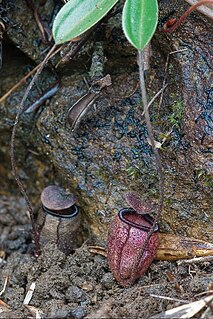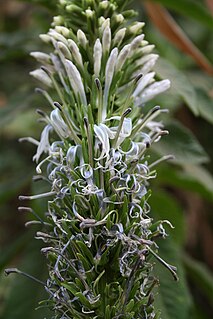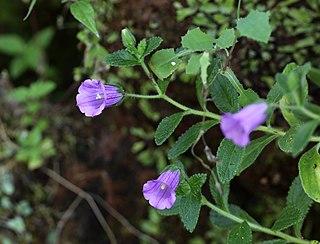
The family Campanulaceae, of the order Asterales, contains nearly 2400 species in 84 genera of herbaceous plants, shrubs, and rarely small trees, often with milky sap. Among them are several familiar garden plants belonging to the genera Campanula (bellflower), Lobelia, and Platycodon (balloonflower). Campanula rapunculus and Codonopsis lanceolata are eaten as vegetables. Lobelia inflata, L. siphilitica and L. tupa and others have been used as medicinal plants. Campanula rapunculoides may be a troublesome weed, particularly in gardens, while Legousia spp. may occur in arable fields.

The purple-throated mountaingem is a species of hummingbird in tribe Lampornithini of subfamily Trochilinae. It is found in Costa Rica, Nicaragua, and Panama.

Nepenthes argentii is a highland Nepenthes pitcher plant native to Mount Guiting-Guiting on Sibuyan Island in the Philippines. It is possibly the smallest species in the genus and does not appear to have a climbing stage.

Cyanea hardyi, known in Hawaiian as hāhā, is a species of flowering plant in the bellflower family, Campanulaceae. This Hawaiian lobelioid is endemic to southern Kauaʻi. It inhabits forested valleys up to an elevation of 790 m (2,590 ft).

Lobelia scaevolifolia is a species of the plant family Campanulaceae. It is endemic to the island of Saint Helena in the South Atlantic Ocean. It was at one time placed as the only species, Trimeris scaevolifolia, in the genus Trimeris. Its common name is St. Helena lobelia.
The Pantanal cat is a Pampas cat subspecies, a small wild cat native to South America. It is named after the Pantanal wetlands in central South America, where it inhabits mainly grassland, shrubland, savannas and deciduous forests.

The mountain avocetbill is a species of hummingbird in the "coquettes", tribe Lesbiini of subfamily Lesbiinae. It is found in Colombia, Ecuador, and Peru.
Odorrana chapaensis is a species of frog in the family Ranidae that is found in southern Yunnan in China and in northern Vietnam. It is likely that it also occurs in nearby areas of Laos.
Campanula balfourii is a species of flowering plant in the bellflower family Campanulaceae. It is endemic to northeastern Socotra, Yemen. Its natural habitat is subtropical or tropical dry forests.
Centropogon rubrodentatus is a species of plant in the family Campanulaceae. It is endemic to Ecuador. Its natural habitat is subtropical or tropical moist montane forests. It is threatened by habitat loss.
Jasione mansanetiana is a species of plant in the family Campanulaceae. It is endemic to Spain. Its natural habitat is rocky areas. It is threatened by habitat loss.

Lobelia columnaris is a species of plant in the family Campanulaceae. It is the only giant Lobelia occurring in West Africa and is found in Cameroon and Equatorial Guinea. Its natural habitat is subtropical or tropical dry forests.
Lobelia hereroensis is a species of plant in the family Campanulaceae. It is endemic to Namibia. It is threatened by habitat loss.

Wahlenbergia angustifolia, also called small bellflower, is a species of plant in the family Campanulaceae. It is endemic to Saint Helena. Its natural habitat is rocky areas. It is endangered because of habitat loss.

Wahlenbergia linifolia, the large bellflower, is a species of plant in the family Campanulaceae. It is endemic to Saint Helena. Its natural habitat is rocky areas. It is threatened by habitat loss.
Cyanea eleeleensis was a rare species of flowering plant in the bellflower family known by the common name Eleele cyanea. It was endemic to Kauai, where it has been declared extinct. It was federally listed as a critically endangered species of the United States in 2010. Like other Cyanea it is known as haha in Hawaiian.

Campanula jacobaea is a species of flowering plants of the Campanulaceae family. The species is endemic to Cape Verde and is listed as vulnerable by the IUCN. Its local name is contra-bruxas-azul. The plant is used in traditional medicine. Campanula jacobaea is shown on a Cape Verdean $5 escudo coin issued in 1994.
Campanula kantschavelii, also known as Kanchaveli's bellflower, is a species of flowering plant in the family Campanulaceae. It is native to Georgia.
Campanula lazica is a species of flowering plant in the bellflower family, Campanulaceae. It is endemic to northeast Anatolia, Turkey.
Campanula seraglio, known as the Serail bellflower, is a species of flowering plant in the family Campanulaceae. It is native to northeastern Turkey.










